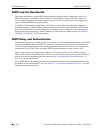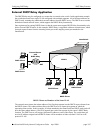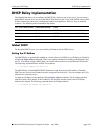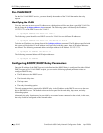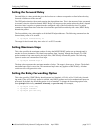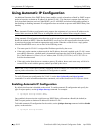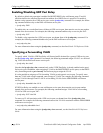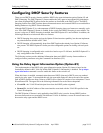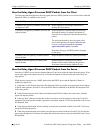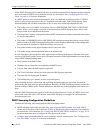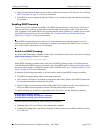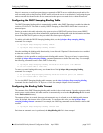
Configuring UDP Port Relay Configuring DHCP Relay
page 18-14 OmniSwitch 6600 Family Network Configuration Guide April 2006
Enabling/Disabling UDP Port Relay
By default, a global relay operation is enabled for BOOTP/DHCP relay well-known ports 67 and 68,
which becomes active when an IP network host address for a DHCP server is specified. To enable or
disable a relay operation for a UDP service port, use the ip udp relay command. For example, the follow-
ing command enables relay on the DNS well-known service port:
-> ip udp relay DNS
To enable relay on a user-defined (not well-known) UDP service port, then enter the service port number
instead of the service name. For example, the following command enables relay on service port 3047:
-> ip udp relay 3047
To disable a relay operation for a UDP service port, use the no form of the ip udp relay command. For
example, the following command disables relay on the DNS well-known service port:
-> no ip udp relay dns
For more information about using the ip udp relay command, see the OmniSwitch CLI Reference Guide.
Specifying a Forwarding VLAN
To specify which VLAN(s) UDP Port Relay will forward traffic destined for a generic UDP service port,
use the ip udp relay vlan command. For example, the following command assigns VLAN 5 as a forward-
ing VLAN for the DNS well-known service port:
-> ip udp relay dns vlan 5
Note that the ip udp relay vlan command only works if UDP Port Relay is already enabled on the speci-
fied service port. In addition, when assigning a VLAN to the BOOTP/DHCP service ports, set the DHCP
relay forwarding mode to per-vlan only first before trying to assign the VLAN.
It is also possible to assign up to 256 forwarding VLANs to each generic service port. To specify more
than one VLAN with a single command, enter a range of VLANs. For example, the following command
assigns VLANs 6 through 8 and VLAN 10 as forwarding VLANs for the NBNS/NBDD well-known
service ports:
-> ip udp relay nbnsnbdd vlan 6-8 10
If UDP Port Relay was enabled on a not well-known service port, then enter the service port number
instead of the service name. For example, the following command assigns VLAN 100 as a forwarding
VLAN for UDP service port 3047:
-> ip udp relay 3047 vlan 100
To remove a VLAN association with a UDP service port, use the no form of the ip udp relay vlan
command. For example, the following command removes the VLAN 6 association with the NBNS/NBDD
well-known service port:
-> no ip udp relay nbnsnbdd vlan 6
For more information about using the ip udp relay vlan command, see the OmniSwitch CLI Reference
Guide.



